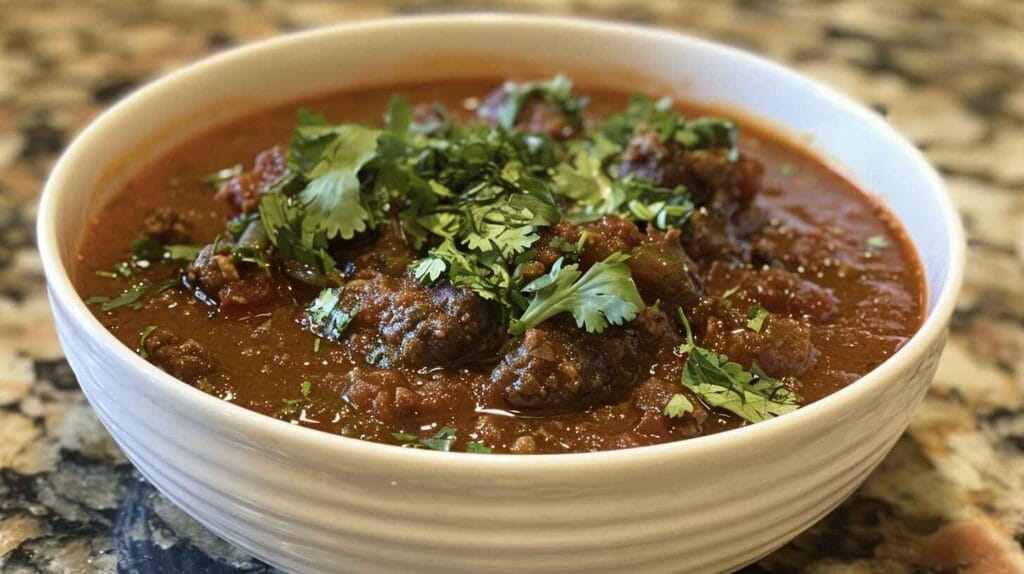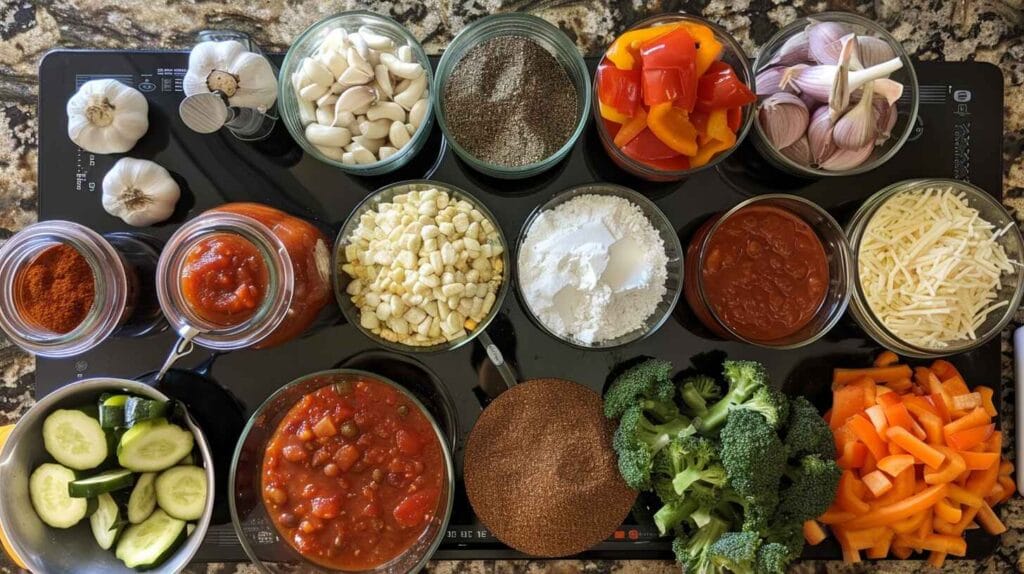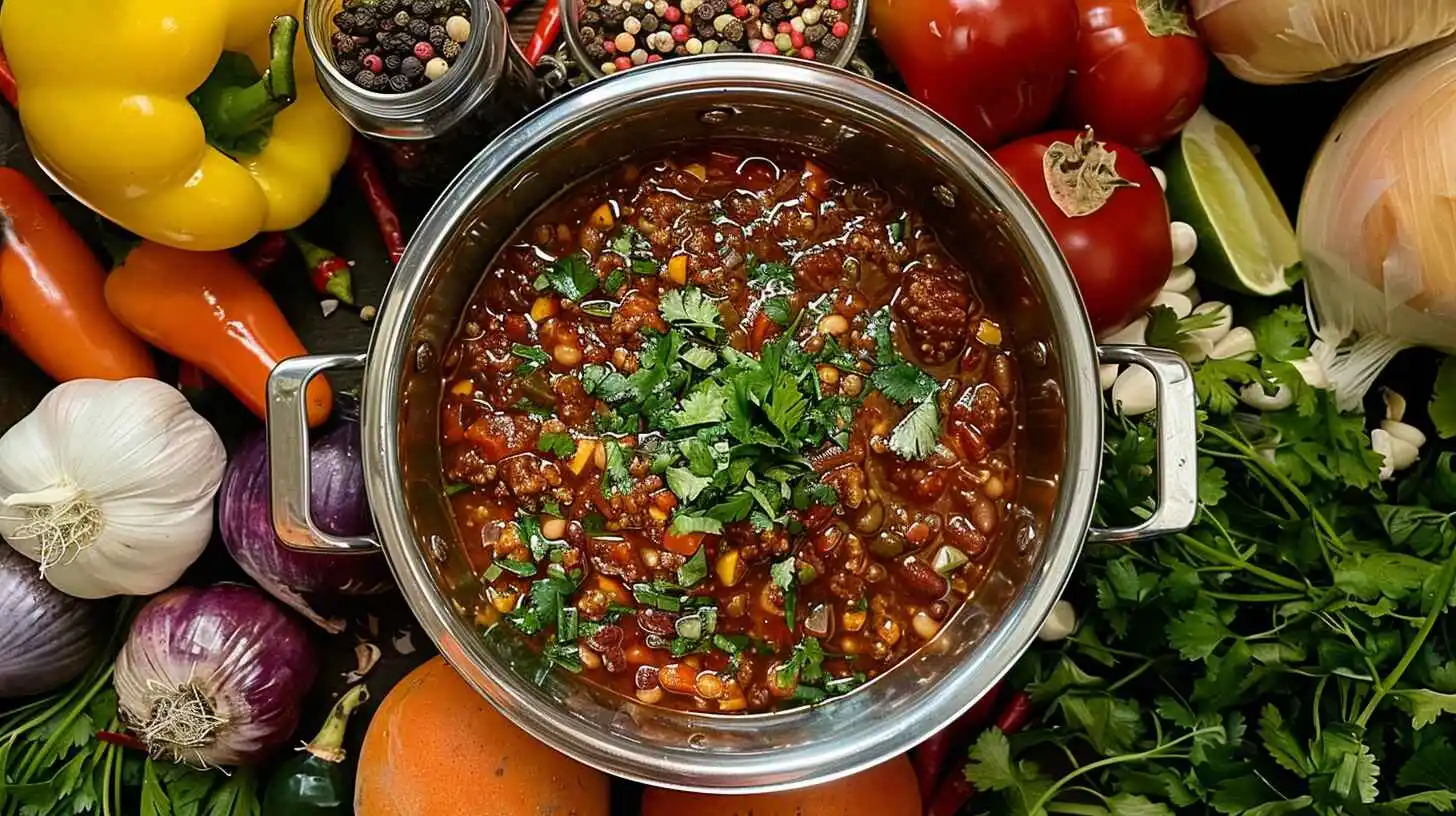Table of Contents
Chili is a beloved comfort food packed with rich flavors and hearty ingredients. Whether served during a football game, a family dinner, or a cold winter night, chili is a go-to dish for many. But as delicious as homemade chili is, many people wonder does homemade chili have a lot of Sodium?
Sodium plays a crucial role in flavoring and preserving food, but too much can lead to health problems like high blood pressure and heart disease. While homemade chili is generally considered healthier than canned or pre-packaged versions, SodiumSodium can sneak in through ingredients like canned beans, broths, and spice mixes.
In this article, we’ll break down how much Sodium is typically found in homemade chili, how it compares to store-bought varieties, and, most importantly, how to reduce the sodium content without sacrificing flavor. By the end, you’ll have a clearer understanding of making a delicious, low-sodium chili that keeps your taste buds and health happy.
Understanding Sodium in Chili

What is Sodium, and Why is it Important?
Sodium is essential for maintaining fluid balance, nerve function, and muscle contractions. However, consuming too much Sodium can negatively impact health, increasing the risk of cardiovascular disease and kidney problems.
The American Heart Association recommends limiting sodium intake to less than 2,300 mg daily (ideally trying to get 1,500 mg). A single bowl of chili can quickly eat into this limit, depending on the ingredients used.
How Sodium Enters Chili
Homemade chili can accumulate Sodium from multiple sources, even if you think you’re cooking from scratch. Here are the most common culprits:
- Canned Beans and Tomatoes – Canned products are notorious for high sodium levels unless labeled “no salt added.”
- Broths and Stocks – Many recipes call for chicken or beef broth, which can be high in Sodium unless you use a low-sodium option.
- Spice Mixes and Chili Powder – Pre-made spice blends often contain added salt.
- Processed Meats – Sausage, bacon, or ham added to chili can drive up SodiumSodium significantly.
Sodium in Homemade vs. Store-Bought Chili
Store-bought chili can contain upwards of 700 to 1,200 mg of Sodium per serving, while homemade chili, depending on the recipe, ranges from 200 to 600 mg per serving. The benefit of homemade chili is that you control what goes in, meaning you can significantly reduce Sodium with a few tweaks.
Factors Affecting Sodium Levels in Homemade Chili
When making homemade chili, sodium levels can vary widely depending on the ingredients and cooking techniques. Understanding what influences sodium content is essential for crafting a healthier dish without sacrificing taste.
Ingredients that Add Sodium
The most significant contributor to Sodium in homemade chili is often the ingredients. Even seemingly harmless additions can pack more Sodium than expected. Here’s a breakdown of the main offenders:
- Canned Beans and Tomatoes Canned beans and tomatoes are chili staples, but they’re often loaded with Sodium to preserve freshness.
- One cup of canned beans can have up to 400-500 mg of Sodium.
- Opt for “no salt added” or rinse regular canned beans thoroughly to cut Sodium by as much as 40%.
- Broths and Stocks Broths provide flavor and richness to chili, but traditional varieties can contain over 800 mg of Sodium per cup.
- Consider using low-sodium or homemade broth to reduce the impact.
- Chili Powders and Spice Mixes Many commercial chili powders and taco seasoning blends contain hidden salt.
- A single tablespoon of chili seasoning can add 150-300 mg of Sodium.
- To skip the salt, make your spice blend using paprika, cumin, garlic powder, and cayenne.
- Processed Meats Meats like sausage, bacon, or chorizo can contribute over 700 mg of Sodium per serving.
- Use lean ground beef, turkey, or chicken to maintain flavor without excessive Sodium.
- Cheese and Garnishes Toppings like shredded cheese, sour cream, and tortilla chips can increase Sodium quickly.
- Use these garnishes sparingly, or swap them for fresh avocado, Greek yogurt, or cilantro.
Cooking Methods and Salt Use
Sometimes, sodium levels can spike simply due to how you cook the chili:
- Seasoning While Cooking – Adding salt gradually can lead to over-seasoning. Instead, taste and adjust at the end.
- Layering Flavors – Rely more on spices, garlic, and onion for flavor, reducing the need for additional salt.
- Simmering Longer – Slow cooking allows flavors to develop naturally, minimizing the need for heavy seasoning.
How to Make Low-Sodium Homemade Chili

Creating a flavorful chili without the exces Sodium is easier. By making smart ingredient choices and adjusting your cooking methods, you can craft a delicious, heart-healthy chili that still satisfies. Let’s dive into the best techniques for reducing Sodium without compromising taste.
Choosing Fresh Ingredients
The foundation of low-sodium chili starts with fresh, whole ingredients. Processed foods are the main culprits for high Sodium, so choosing fresh vegetables and meats helps control what goes into your pot.
- Fresh Tomatoes – Instead of canned tomatoes, use fresh Roma or vine-ripened tomatoes. Blanch and peel them for a rich base.
- Dry Beans – Soak and cook dry beans instead of using canned ones. Not only is this cost-effective, but it also eliminates unnecessary Sodium.
- Fresh Vegetables – Bell peppers, onions, garlic, and carrots add natural flavor without salt.
Replacing Canned Goods
If you’re short on time and need to use canned products, choose low-sodium or no-salt-added versions. These can often be found alongside regular canned items at the grocery store.
- Beans – Rinse canned beans under cold water for 30 seconds to remove up to 40% of the Sodium.
- Tomatoes – Use no-salt-added diced or pureed fresh tomatoes for a quick, sodium-free alternative.
- Broth – Replace store-bought broth with homemade vegetable or chicken stock. Alternatively, use water infused with herbs and garlic.
Spice Blends and Seasonings
Store-bought spice packets often hide salt and preservatives. Crafting your spice blend makes it easy to eliminate excess Sodium while boosting flavor.
DIY Chili Spice Mix (No Salt Added)
- 2 tbsp paprika
- 1 tbsp cumin
- 1 tbsp garlic powder
- 1 tbsp onion powder
- 1 tsp oregano
- 1/2 tsp cayenne pepper (adjust for heat preference)
- 1 tsp black pepper
Mix these spices and store them in an airtight container. Use this blend in place of pre-packaged chili powders.
Balancing Flavors Without Salt
To keep chili flavorful without adding salt, focus on layering flavors and using natural, sodium-free enhancers.
- Citrus – A squeeze of lime or lemon juice at the end brightens the dish.
- Vinegar – Apple cider or balsamic vinegar adds a subtle tang that enhances other flavors.
- Herbs – Fresh cilantro, parsley, or green onions provide a pop of freshness.
- Umami Boosters – Mushrooms, sun-dried tomatoes, and nutritional yeast give chili a decadent flavor without added salt.
Benefits of Low-Sodium Chili
Reducing SodiumSodium in homemade chili doesn’t just improve flavor control—it has significant health benefits that can positively impact your overall well-being. From lowering blood pressure to reducing the risk of heart disease, there are many reasons to opt for a low-sodium version of this comforting dish.
Health Advantages
- Heart Health
- High sodium intake is directly linked to hypertension (high blood pressure), a leading risk factor for heart disease and stroke. Lowering the Sodium in your chili helps protect your heart and improves cardiovascular health.
- Reduced Risk of Kidney Disease
- Excess Sodium can strain the kidneys, leading to potential kidney damage over time. A low-sodium diet reduces this strain, promoting better kidney function.
- Lower Water Retention
- High-sodium foods can cause bloating and water retention. You may notice reduced bloating and improved overall comfort after meals by cutting back.
- Better Weight Management
- While Sodium itself doesn’t add calories, high-sodium foods are often linked with processed, calorie-dense meals. Shifting to a fresher, low-sodium chili encourages a healthier, more balanced diet.
- Improved Flavor Sensitivity
- Over time, reducing salt enhances your palate, making you more sensitive to ingredients’ natural flavors. This can lead to greater enjoyment of meals without the need for heavy seasoning.
Retaining Flavor While Being Healthy
Many people worry that cutting Sodium will make their food bland. The truth is that you can achieve a delicious, rich chili with alternative flavor enhancers that bring depth and complexity to the dish.
- Slow Cooking – Letting chili simmer for longer helps flavors develop naturally.
- Roasting Vegetables – Roasting peppers, garlic, and onions before adding them to the chili intensifies their flavor.
- Smoked Ingredients – Smoked paprika or fire-roasted tomatoes can bring a smoky richness without salt.
Frequently Asked Questions (FAQ):
1. How Much Sodium is Too Much in Chili?
The ideal sodium content for a serving of chili depends on dietary needs, but most health guidelines recommend keeping meals under 600 mg of Sodium per serving. Serving 200 to 400 mg of Sodium for chili is considered low Sodium and heart-healthy. If you’re looking for ways to lower Sodium while keeping rich flavors, check out this low-sodium chili recipe, which is hearty, rich, and easy to make.
2. Can I Make Chili Without Salt?
Yes! To build flavor, you can make chili entirely salt-free by using fresh herbs, citrus, garlic, and spices. Consider incorporating umami-rich ingredients like mushrooms or roasted vegetables for more creative ideas. If needed, a great way to manage excess salt is to apply tips from Will a Potato Remove Salt from Chili? The Truth You Need to Know.
3. What Are the Best Low-Sodium Chili Recipes?
Low-sodium chili recipes often focus on the following:
- Fresh vegetables like bell peppers and tomatoes.
- Dry beans instead of canned.
- Lean meats or plant-based proteins.
- DIY spice blends without added salt.
Try these 7 Simple Fixes to Reduce Sodium in Canned Chili for inspiration. Slow-cooked flavors and roasted ingredients can build a deep, satisfying taste without adding Sodium.
4. Are Spicy Chilis Lower in Sodium?
Spicy chili often contains less Sodium because the heat from peppers like jalapeños, cayenne, or chipotle enhances flavor, reducing the need for salt. However, some spice mixes still contain SodiumSodium. Always check ingredient labels or learn more about alternatives in this guide to crafting healthier spice blends.
5. Does Chili Powder Contain Sodium?
Some chili powders and seasoning blends contain SodiumSodium, especially those labeled as taco or chili seasonings. Pure chili powder typically contains little to no sodium. If you’re curious about alternatives, consider making your blend at home with this How to Make Your Baking Powder guide, which can be adapted for various spice mixes.
6. How Can I Measure Sodium in My Chili?
To measure SodiumSodium in your homemade chili:
- Calculate SodiumSodium per ingredient by checking nutrition labels.
- Use online nutrition calculators to input each ingredient.
- Keep track of serving sizes for accurate measurement.
If you aim for precision in low-sodium cooking, these Simple Fixes to Reduce Sodium can help ensure you stay within healthy limits.
Conclusion
Homemade chili can be a comforting, flavorful meal that fits into a healthy, low-sodium diet with just a few adjustments. By swapping out canned goods for fresh ingredients, using low-sodium alternatives, and crafting your spice blends, you can significantly reduce the sodium content without sacrificing taste.
The appeal of chili made at home is its versatility. Whether you prefer it packed with beans, loaded with vegetables, or rich in meat, there are countless ways to prepare it while keeping it heart-healthy. Reducing SodiumSodium benefits your health and can lead to discovering new flavors and cooking techniques that elevate your chili to new heights.
So, the next time you whip up a pot of chili, remember delicious doesn’t have to mean salty. With the right balance of fresh ingredients and bold spices, you can enjoy a hearty bowl of homemade chili that’s as good for your heart as it is for your taste buds.
